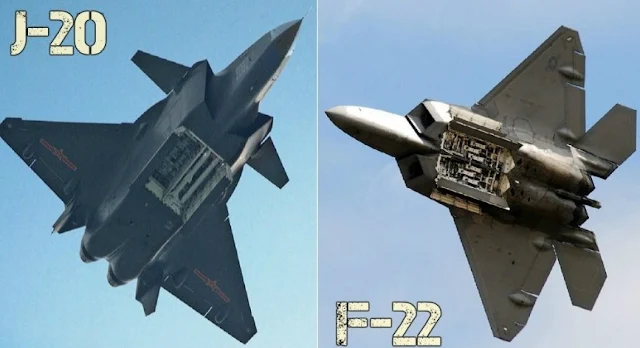 |
| China's J-20 Mighty Dragon VS US F-22 Raptor |
International Military - It's not new anymore that the J-20 Mighty Dragon and the F-22 Raptor are often compared. The reason is, both are the result of the work of the two superpowers today, namely China and the US.
The J-20 Mighty Dragon from China while the F-22 Raptor from the US. Both are even claimed to be the most influential stealth fighter jets today.
In terms of technology, the US is definitely superior to China. In fact, the Raptor has been built for a long time and has been around since 2005. But who would have thought, the J-20 turned out to have an advantage over the F-22 Raptor.
Quoted from the Eurasian Times, the J-20 Chengdu Aircraft Corporation is a delta wing fighter. The aircraft is believed to be poor in kinematic performance. As is known, the technology niche is only owned by the United States, Britain, France, and Russia.
The front-swept rear-swept canard allows for some incredible maneuverability by cutting off airflow. However, some experts believe it also compromises stealth by providing a better surface for radar emissions to bounce off of.
In addition, the J-20 Mighty Dragon was powered by a Russian AL-31F turbofan before being replaced with a WS-10C engine. The jet is also larger at 69 feet and without the powerful engines and thrust-vectoring nozzles. Many also believe that the J-20 cannot perform tight maneuvers in aerial combat which gives the F-22 an advantage in this domain.
However, the J-20's shortcomings in performance and kinematic speed are believed to outperform advanced electronics, especially Luneburg lenses. This is a small device used to intentionally expose stealth fighters to friendly forces during exercises, suggesting that the J-20's true stealth features are not yet known.
In addition, there are 2 other advantages of the F-22, namely the helmet-mounted screen for the pilot and the Beyond Visual Range (BVR) missile range. In addition, the J-20 carries the PL-15, the world's longest-range BVR that can reach a range of over 300 kilometers. The HMD also gives its pilots the ergonomic advantage of not having to keep looking at the cockpit screen as all view is directly beamed onto their helmet visor. This reduces the stress of flying, especially in contested complex battlespace situations.
The F-22 does not have a radar-marked Infrared Search and Track (IRST) that can help detect medium ranges. A program to integrate IRST into it only started this year.
On the other hand, China's stealth technology is allegedly the result of "stealing" from the US through hacking. It's just a not-so-disputed conjecture, but it's not the first time China has taken such an action.
Quoted from sandboxx, China's Chengdu J-10 is directly based on intelligence purchased by China from Israel in the 1980s for the malfunctioning Lavi fighter, based on the American F-16.
Later, China's Shenyang J-11 and subsequent J-16s were based on the Soviet Su-27 production line that China purchased in 1989. The Shenyang J-15, China's current main carrier-based fighter is also based on the Russian Su-33 platform.
However, China does not get it directly from Russia. When Moscow refused to provide the Chinese government with plans for the aircraft, Beijing only purchased a prototype fighter from Ukraine (then known as the T-10K-3) and simply reverse engineered it.
